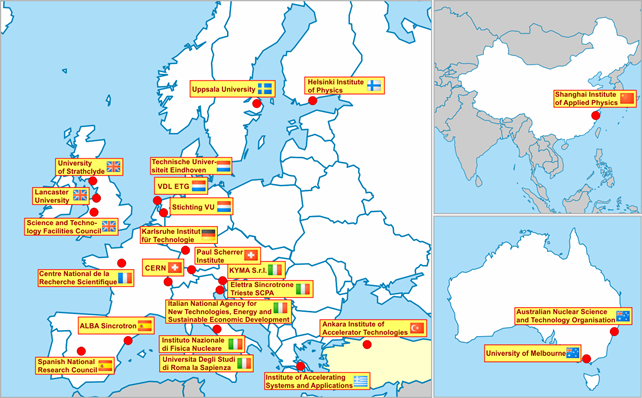After years of intense R&D carried out at SLAC (USA) and KEK (Japan) for the NLC/JLC (Next Linear Collider / Japan Linear Collider) projects and at CERN with collaborators in the context of the CLIC study (Compact Linear Collider), and following the successful pioneering experience of the Elettra (Italy) and PSI (Switzerland) laboratories, the X-band technology takes an important leap forward.
The Horizon 2020-funded project, CompactLight, will soon begin to design the first hard X-ray Free Electron Laser based on 12 GHz X-band technology. A consortium of 21 leading European institutions, including industries, together with the Shanghai Institute Of Applied Physics, the Australian Synchrotron, and the University of Melbourne, are partnering up to achieve this ambitious goal within the 36-month duration of the recently-awarded grant. The ambition of the CompactLight collaboration goes even beyond compact acceleration, as the consortium aims at simultaneously investigating and developing the next generation of undulators.

Map of CompactLight partners (Image credit: CompactLight consortium)
During the past decades, Synchrotron Radiation facilities have seen an impetuous growth as a fundamental tool for the study of materials in a wide spectrum of sciences, technologies, and applications. The latest generation of light sources, the Free Electron Lasers (FELs), capable of delivering high-intensity photon beams of unprecedented luminosity and quality, provided a substantially novel way to probe matter. Currently, the FELs operating in Europe are three: FERMI @Elettra, FLASH and FLASH II (DESY), operating in the soft X-ray range, and two are under commissioning, SwissFEL (PSI) and EuroXFEL (Germany), which will operate in the hard X-ray scale. Yet, this field still has very high, largely unexplored, potentials for science and innovation.
While most of the worldwide existing FELs use conventional normal conducting 3 GHz S-band linacs, others use newer designs based on 6 GHz C-band technology, increasing the accelerating gradient with an overall reduction of the linac length and cost. CompactLight gathers the world-leading experts both in the domains of X-band acceleration and undulator design, and intends to design a hard X-ray FEL facility beyond today’s state of the art, using the latest concepts for bright electron photo injectors, very high-gradient X-band structures at 12 GHz, and innovative compact short-period undulators. If compared to existing facilities, the proposed facility will benefit from a lower electron beam energy, due to the enhanced undulators performance, be significantly more compact, as a consequence both of the lower energy and of the high-gradient X-band structures, have lower electrical power demand and a smaller footprint.
A successful outcome of CompactLight might have a much wider impact: affirming X-band technology as a new standard for accelerator-based facilities and advancing undulators to the next generation of compact photon sources. This will facilitate the widespread distribution of compact X-band based accelerators, as well as the development of compact X-ray FEL facilities across and beyond Europe.